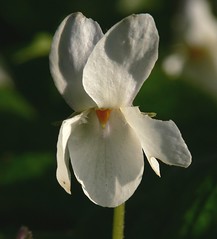I have transferred this story of the viola odorata to Janita's Attar as it was the riviniana ( wood or dog violet) that the physicians used and not the odorata (sweet violet).... I have removed the non-pertaining material about the project now. I am delighted to have identified it with the help of Andrine Olson-Kirschenman. The thread originally came from the NP group.
Walking home yesterday from adjudicating an Eisteddfod at Gwernyfed High School . ...I live halfway up a mountain and it was beautiful day, ..... The banks are full of celandine , I also noted swathes of tiny white flowers dotted alongside and amongst the celandine .... my curiosity to draw nearer... I realised they were tiny white violets. I delicately picked one and held it up and sniffed lightly...... very faintly almost imperceptibly the most exquisite violet aroma became apparent...... just lovely..... when I reached home I came to flickr to see If they had a photo to identify the type but I can't see it. checked white violet in google too and welsh field violet and nothing..... I will get Mina to take a photo and perhaps one of you may recognise the variety. there is no veining of colour at all. very tiny and pert with just a yellow orange centre......
the daffodils are abundant as the primroses, celandine....everywhere on the banks at the sides of the country roads...... the daisies are beginning .... the lambs are frolicking ...........eau to be in the marches......
Hi Janita,Funny you should write this -- I was just reading about violets yesterday in Roy Genders' Scented Flora of the World. Your white violet could be one of two that I read of there:(Originally from "Pansies and Violas", published in 1892 by Messrs Dobbie and Co, in words by one Dr. Stuart)
"It was... ten years before I succeeded in finding a really rayless viola. In Queen Victoria's Jubilee Year whilst walking round a seed bed, I found what I had long been seeking -- a pure white rayless self. It was a warm night and the perfume from the blooms attracted my attention."...A box of bloom was sent to William Robinson, editor of The Garden, who at once recognized a new strain. It was given the name of Violetta, and quickly became a favourite in the cottage garden... 'No family has given our gardens anything more precious'. Almost a century later, the same may be said of it and yet it is known to few gardeners."V. odorata. The Sweet Violet, is distributed from the British Isles, across northern and southern Europe to the Himalayas and northern Asia... The flowers are borne from January to June, depending on the locality and are violet-blue, white or purple, the side petals with or without a tuft of hair, whilst the spur is short."
So, you could have Violetta, or it could be Viola odorata. Or it could be something else that is still a mystery to me. But given that Roy Genders was writing specifically about flora in the British Isles, it could very likely be one of those two.Whatever they are, I would gather some if you can, and try an enfleurage. I have a Viola odorata enfleurage going right now. It's amazing how those little teeny flowers pack such a wallop of scent! And they don't break down into mush in the enfleurage -- they dry up and still smell good! I may even put them into something else after I pull them from the enfleurage -- maybe I'll attempt a little tincture... The only current drawback is that I'm using crisco, and so will need to store it in the fridge or freezer until I can wash the fat with alcohol so it doesn't go bad
- janita
- Natural Perfume, Music and Embroidery this Trinity weave through my life. They support and give each other inspiration. It is my lifes work and profession. I think about Natural Perfume everyday. It is my reason d'etre. It brings joy, fulfills my soul. Creating beautiful perfumes from flowers, fruits and resins is superlunary. I am besotted, obsessed, deeply in love.
Tuesday, 3 April 2007
Subscribe to:
Comments (Atom)



